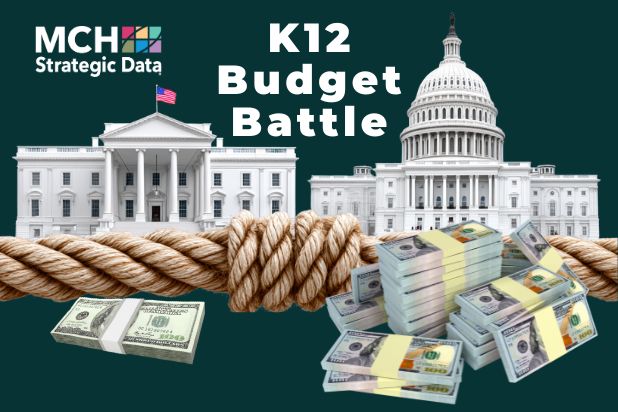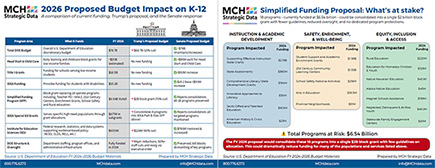
August 11, 2025 | Peter Long
A K-12 Budget Battle Is Unfolding: Trump’s Cuts vs. Senate's Status Quo
Never miss a Moment: Sign up for MCH's Monday Marketing Moment here!
The future of Federal investment dollars to enhance the funding for K-12 education is now at the center of a potential standoff in Washington, as the Trump administration’s FY 2026 budget proposal faces a bipartisan rejection from the U.S. Senate. The Senate’s recent August 1st Appropriations Committee approved a funding bill that preserves the 2024 status quo and actually increases the Federal investment dollars going to IDEA and Title 1 programs for the 2025 – 2026 K-12 education programs budget.
President Trump’s FY 2026 education budget request proposes a 15% cut – approximately $12 billion – to the U.S. Department of Education, reducing its funding from $78.7 billion in FY 2025 to $66.7 billion. The centerpiece of this proposal is the creation of a K-12 Simplified Funding Program (SFP) that would consolidate 18 individual federal education programs and six IDEA programs totaling $6.54 billion into a single $2 billion block grant. This represents a 70% drop in funding for these programs.
See some of the many proposed cuts that were detailed in that request with our 2026 Proposed Funding PDF.
For those marketing products and services to the K-12 sector, this standoff offers potential relief from further budget cut but also continues the budget uncertainty problems as this battle of different budgets plays out.
The Administration’s FY 2026 K-12 Budget Proposal: Massive Reductions, Sweeping Consolidations
As shown in our funding chart of the Trump budget analysis, the SFP replaces programs that fund literacy, professional development, rural education, after-school programming, school safety, enrichment, and more. This new SFP also consolidated six specialized programs targeting rural, native schools, and homeless student populations. The proposal lacks specifics on how these funds would be allocated under the new program, leading to widespread uncertainly about how to use or get access to these funds.
Administration Cuts to Research & Oversight
In addition to K-12 program consolidation, Trump’s budget cuts target the Department of Education’s research arm called “The Institute for Education Sciences (IES)” by 80%, dropping its funding from $600 million to $124 million. The proposal effectively dissolves critical work from the National Center for Education Statistics (NCES), Regional Education Labs, and Statewide Longitudinal Data Systems, all of which underpin evidence-based policymaking.
Special Education Changes
Finally, the administration also proposes folding six special education programs, including preschool grants and personnel development, into the broader IDEA Part B “Grants to States” program. This move could divert funds from staff training, preschool support, and parent engagement, and weakening support for students with disabilities.
Senate Rejects Administration Budget Proposal, Boosts K-12 Funding Instead
In a strong bipartisan move, the Senate Appropriations Committee voted 26-3 to approve a $79 billion FY 2026 education funding bill, directly opposing Trump’s proposed cuts. Not only does the Senate proposal restore existing programs, but it also increases Title I and IDEA funding by $50 million each, while maintaining current levels across other competitive and formula-based grants.
Senate's Position:
- Preserves all 18 programs targeted for consolidation
- Keeps the Department of Education fully intact
- Maintains $793 million funding for the Institute for Education Sciences
- Funds Title I at $18.5B and IDEA at $15.2B
- Adds $85 million each to Head Start and Child Care Block Grants
The Senate’s bill explicitly states that it blocks the administration from dismantling or moving Title I and special education programs outside the DOE. It also mandates the timely release of formula grants after the administration delayed $6.2 billion earlier this year, disrupting school operations, canceling contracts, and triggering staff layoffs.
Veto or Compliance?
With the Senate and potentially the House poised to pass an education budget that completely rejects the Trump administration’s vision, political observers are now asking. Will the Trump administration veto the bill? Or - Will the administration embrace the Senate bill’s intent? Or – Will the Administration decide to take other steps like further executive actions to push the proposed Administration agenda further regardless of the Senate wishes?
Given Trump’s March 2025 executive order to shutter the Department of Education “to the maximum extent appropriate,” it’s possible the administration may continue shrinking the department internally even if Congress restores funding. With no staff left to execute a fully funded budget the effectiveness of the Senate’s plans could still be an issue. The Department of Education has already seen thousands of staff and administrative cuts (more than 50% of the entire DOE workforce is already gone). Many fear that these programs have already been stopped due to dissolving DOE internal capacity (already down more than 50%) to administer these programs.
What Does All This Mean for K-12 Vendors and Marketers?
Despite the political uncertainty, the Senate's rejection of the Trump budget and their overwhelming restoration of all the programmatic funding offer a welcome boost and crucial reprieve for the K-12 marketer. Vendors and service providers alike, who have faced declining leads, canceled contracts, and budget freeze tied to the looming federal cuts, can now see this as a short-term victory.
Conclusion: A Critical Inflection Point
The 2025 - 2026 K-12 federal funding process has just begun. While it does look hopeful for businesses that depend in the Federal support of K-12, it also underscores a broader battle yet to be fought over the future of Federal funding for K-12 education. With the current Administration’s proposal focused on reducing funding, further decentralizing dollars and consolidating / simplifying various programs and further reducing the DOE staffing and oversight capabilities, the Senate’s budget proposal stands as a forceful counter that reaffirms federal investment and structure.
For K-12 marketers and education vendors, the months ahead are pivotal. But for now, the Senate’s move provides a much-needed shot in the arm for an industry grappling with cascading challenges stemming from increased costs from tariffs to economic slowdowns, to shifting curriculum standards and elimination of DEI mandates (to name just a few). The road to FY 2026 remains uncertain, but this round appears to go to advocates of strong, federally supported K-12 education.
Keep your finger on the pulse of what's happening in funding:
Download our 2025 Proposed Budget PDF and keep your efforts streamlined.
⏪REWIND - Get the School Calendar 2025/2026
Download our School Calendar Reference Guide for the 2025/2026 school year and get key insights from over 80,000 school calendars across the U.S.
About MCH
For nearly a century, MCH has empowered educational marketers with the data, tools, and solutions needed to thrive. Our cutting-edge technology continuously updates and verifies millions of educator records, ensuring you have the most accurate information for your campaigns.
Use our free ListBuilder tool to explore our education data, or Contact Us to strategize as a team.
Need More Time?
Due to inactivity, you will be logged out within 5 minutes.
To stay logged in, please select Stay Logged In.






 Logout
Logout